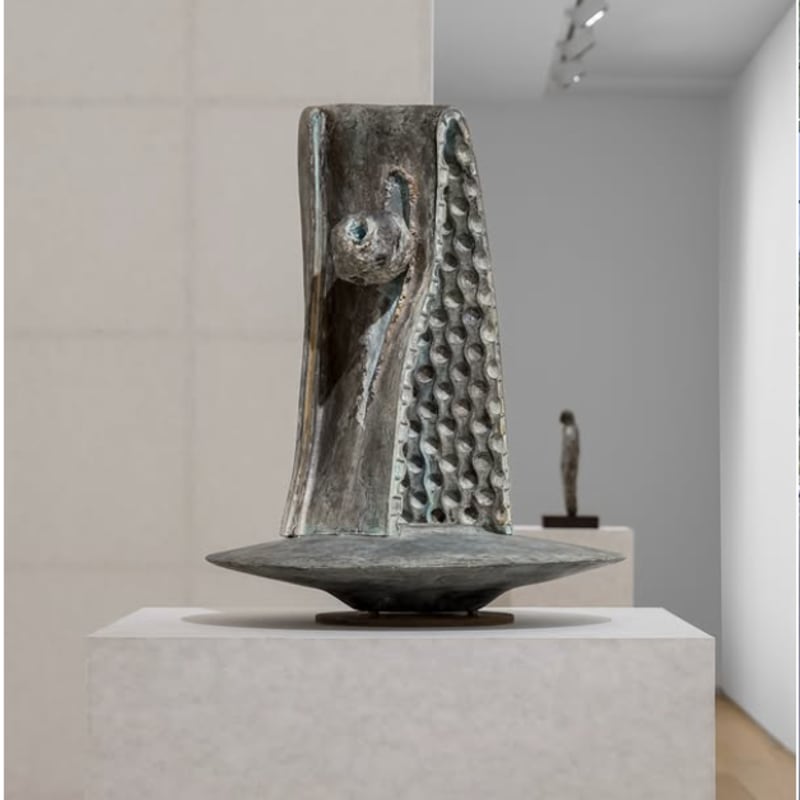The exhibition highlights practices that challenged contemporaneous conceptions of art, whether through a radically egalitarian approach to materials or a deepened engagement with the physical space or the sociopolitical concerns of the world surrounding them.
Wall Drawing #122 (1972) is part of Sol LeWitt’s visionary series of large-scale mural drawings which he commenced in 1968 and pursued until his death in 2007. Crystallising his cerebral practice, LeWitt conceived of specific instructions and diagrams to enable his assistant drafters to execute the works directly onto the wall. In the artist’s words, ‘the idea or concept is the most important aspect of the work’ (Artforum, 1967).
Wall Drawing #122, 1972
Blue crayon, black pencil grid.
at random, using arcs from corners and sides, straight, not straight, and broken lines.


Yellow Nunn, 1975
Painted and chromium-plated steel
115 x 163 x 102 cm (45.28 x 64.17 x 40.16 in)

Donald Judd established a groundbreaking three-dimensional visual language, exemplified by this work from 1973 which intervenes directly in the space, jutting out from the wall upon which it is mounted. Judd gives primacy to the inherent qualities of the medium and, as such, Untitled encapsulates his conception of ‘real’ art - one that speaks for itself, emphasising what is.
Copper


Painted cardboard boxes
137 x 33 x 30.5 cm (53.94 x 12.99 x 12.01 in)


Bank Job (Spread), 1979
acrylic paint and reflector on gessoed wooden construction, in 15 parts


Untitled, 1974
Gloss paint on PVC
34 x 34 cm (13.39 x 13.39 in)
The fog, which fills the room at allotted times, orients and disorients viewers in the room installation, adding an experiential dimension to the work. As Rosenquist set forth, ‘I had an idea about dislocation in space. […] To achieve the feeling of dematerialization, I wanted to create an effect of painted panels that appeared to be floating in space. […] It was an extension of my concept of dissolving the painting as an object, immersing the viewer in the painting, and making it an environment – color as a state of mind.’
Horizon Home Sweet Home, 1970
27 panels, each: 259.1 x 101.6 cm (102 x 40 in)

Screen Test, 1975
Oil on canvas

Private Domain, 1969
Oil on linen

Climbing (Brushstroke), 1972

Untitled 1, 1980/2023
Vinyl and water
152 x 36.5 cm (59.84 x 14.37 in)

To shape shift paradigms I find different ways to use materials others consider useless or insignificant providing proof that the disregarded and disenfranchised may also have the resilience and reformative ability to find their poetic selves. — Senga Nengudi
Senga Nengudi
Water Composition III, 1969–70/2018
Heat-sealed vinyl, coloured water, rope
91 x 120 x 73 cm (35.83 x 47.24 x 28.74 in)

Untitled, c. 1970
Grease and dry pigment on paperboard
74 x 48.5 cm (29.13 x 19.09 in)
Piss Painting, 1977–78
Urine on linen


Green Half Circle, 1973
Acrylic on draped canvas
269.2 x 118 cm (106 x 46.5 in)

Acrylic on draped canvas
271.8 x 120.7 cm (107 x 47.5 in)

Small Vanishing Theatre, 1975
Oil on canvas
30.5 x 45.7 cm (12 x 18 in)


Women and Smoke, California, 1971–1972, remastered in 2016 and edited by Salon94 in 2017
AP1, Ed. of 20 + 2APS


















































































































































































































